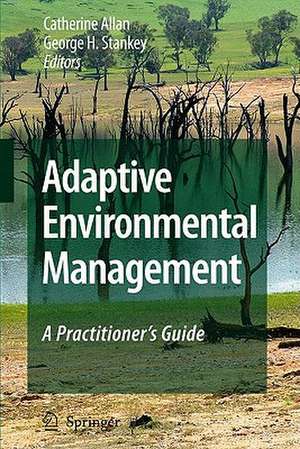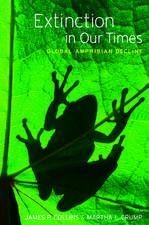Adaptive Environmental Management: A Practitioner's Guide
Editat de Catherine Allan, George Henry Stankeyen Limba Engleză Paperback – 9 iun 2009
With a view to facilitating better practice, this new book presents lessons learned from case studies, to provide managers with ready access to relevant information. Cases are drawn from a number of disciplinary fields, including management of protected areas, watersheds and farms, rivers, forests, biodiversity and pests. Examples from Australia, New Zealand, the USA, Canada, the UK and Europe are presented at a variety of scales, from individual farms, through regional projects, to state-wide planning.
While the book is designed primarily for practitioners and policy advisors in the fields of environmental and natural resource management, it will also provide a valuable reference for students and researchers with interests in environmental, natural resource and conservation management.
Preț: 730.02 lei
Preț vechi: 890.27 lei
-18% Nou
Puncte Express: 1095
Preț estimativ în valută:
139.73€ • 151.83$ • 117.45£
139.73€ • 151.83$ • 117.45£
Carte tipărită la comandă
Livrare economică 22 aprilie-06 mai
Preluare comenzi: 021 569.72.76
Specificații
ISBN-13: 9789048127108
ISBN-10: 9048127106
Pagini: 368
Ilustrații: XVI, 351 p.
Dimensiuni: 155 x 235 x 28 mm
Greutate: 0.51 kg
Ediția:2009
Editura: SPRINGER NETHERLANDS
Colecția Springer
Locul publicării:Dordrecht, Netherlands
ISBN-10: 9048127106
Pagini: 368
Ilustrații: XVI, 351 p.
Dimensiuni: 155 x 235 x 28 mm
Greutate: 0.51 kg
Ediția:2009
Editura: SPRINGER NETHERLANDS
Colecția Springer
Locul publicării:Dordrecht, Netherlands
Public țintă
Professional/practitionerCuprins
Understanding Adaptive Management.- Components of Adaptive Management.- Varying Contexts.- Lessons Learned from Adaptive Management Practitioners in British Columbia, Canada.- Using Adaptive Management to Meet Multiple Goals for Flows Along the Mitta Mitta River in South-Eastern Australia.- Adaptive Management of a Sustainable Wildlife Enterprise Trial in Australia's Barrier Ranges.- Learning About the Social Elements of Adaptive Management in the South Island Tussock Grasslands of New Zealand.- Kuka Kanyini, Australian Indigenous Adaptive Management.- Crisis as a Positive Role in Implementing Adaptive Management After the Biscuit Fire, Pacific Northwest, U.S.A..- Tools for Adaptive Management.- Modelling and Adaptive Environmental Management.- Lessons Learned from a Computer-Assisted Participatory Planning and Management Process in the Peak District National Park, England.- Signposts for Australian Agriculture.- Environmental Management Systems as Adaptive Natural Resource Management: Case Studies from Agriculture.- The Adaptive Management System for the Tasmanian Wilderness World Heritage Area — Linking Management Planning with Effectiveness Evaluation.- The Importance of People.- Adaptive Management of Environmental Flows — 10 Years On.- Collaborative Learning as Part of Adaptive Management of Forests Affected by Deer.- Effective Leadership for Adaptive Management.- Institutionalising Adaptive Management: Creating a Culture of Learning in New South Wales Parks and Wildlife Service.- Adaptive People for Adaptive Management.- Conclusion.- Synthesis of Lessons.
Textul de pe ultima copertă
Adaptive management is the recommended means for continuing ecosystem management and use of natural resources, especially in the context of ‘integrated natural resource management’. Conceptually, adaptive management is simply learning from past management actions to improve future planning and management. However, adaptive management has proved difficult to achieve in practice.
With a view to facilitating better practice, this new book presents lessons learned from case studies, to provide managers with ready access to relevant information. Cases are drawn from a number of disciplinary fields, including management of protected areas, watersheds and farms, rivers, forests, biodiversity and pests. Examples from Australia, New Zealand, the USA, Canada, the UK and Europe are presented at a variety of scales, from individual farms, through regional projects, to state-wide planning.
While the book is designed primarily for practitioners and policy advisors in the fields of environmental and natural resource management, it will also provide a valuable reference for students and researchers with interests in environmental, natural resource and conservation management.
With a view to facilitating better practice, this new book presents lessons learned from case studies, to provide managers with ready access to relevant information. Cases are drawn from a number of disciplinary fields, including management of protected areas, watersheds and farms, rivers, forests, biodiversity and pests. Examples from Australia, New Zealand, the USA, Canada, the UK and Europe are presented at a variety of scales, from individual farms, through regional projects, to state-wide planning.
While the book is designed primarily for practitioners and policy advisors in the fields of environmental and natural resource management, it will also provide a valuable reference for students and researchers with interests in environmental, natural resource and conservation management.
Caracteristici
Handbook designed with the needs of on-ground practitioners and policy advisors in mind: Includes in-depth examples providing "how to" information Broad coverage on different types of natural resources and case studies at a wide range of scales The explicit effort to address different levels of institutional scale Topicality and international relevance, multidisciplinary collaboration - international scope Includes supplementary material: sn.pub/extras





